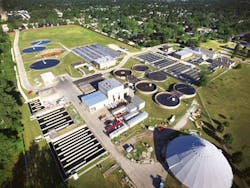About the author: Sara Samovalov is associate editor for W&WD. Samovalov can be reached at [email protected] or 847.954.7966.
Located in southeastern Wisconsin, the Kenosha Wastewater Treatment Plant (WWTP) supplies water to almost 110,000 people. It utilizes a pioneering biosolids handling process that promotes energy efficiency and reduces the amount and cost of biosolids sent to the landfill.
The Kenosha WWTP first went online in 1940. Secondary treatment was added in 1967, and the facility was upgraded again in 1985 to increase its capacity. The plant is owned by the city of Kenosha and serves an 85.7-sq-mile area. It treats an average of 22 million gal per day (mgd) and its maximum daily flow is 68 mgd.
Wastewater enters the plant through a 99-in. sewer. Sewage then flows through two bar screens and two grit removal chambers into nine primary clarifiers. It is treated with ferric chloride to remove phosphates before entering six large aeration basins. It then settles in four final clarifiers, is injected with chlorine, travels through chlorine contact tanks, is injected with sulfur dioxide and is discharged into Lake Michigan. The entire operation takes about 16 hours to complete.
It is the plant’s sludge treatment process, however, that differentiates it from the rest.
Overhauling Biosolids
The Kenosha WWTP recently embarked on an overhaul of its biosolids recovery system. The crowning achievement of the project was the installation of a PONDUS thermochemical hydrolysis process, the first such installation in North America. Other technologies implemented include Centrisys thickening centrifuges for primary and waste-activated sludge (WAS); a Vaughan Rotamix mechanical hydraulic mixing system; a Sülzle-Klein compact belt dryer; a biogas conditioning system by Unison Solutions; two Kraft Power CHP generators; and an odor control system.
PONDUS hydrolyzes the plant’s WAS stream by injecting a small dose of sodium hydroxide (caustic soda), which increases the solution’s pH to roughly 11. The solution then is heated to 149°F for just more than two hours, causing the cell walls in the WAS to break apart and bringing the pH of the solution back to neutral. The process makes the WAS stream more digestible and generates biogas to fuel other processes in the plant.
After going through the PONDUS process, the sludge enters a dewatering centrifuge, is dried on a compact belt dryer and is deposited into the bed of a dump truck to be taken to the local landfill.
Striving Toward Efficiency
Installing the compact belt dryer enabled the Kenosha WWTP to achieve U.S. Environmental Protection Agency Class-A designation for its biosolids, meaning they can legally be used as fertilizer.
The plant is “pursuing options for the beneficial reuse” of its biosolids, according to Curt Czarnecki, P.E., director of engineering at Kenosha Water Utility. “Our options include land application on local farm fields; an additive to the city yard waste compost product; a fuel supplement at a local coal-fired power plant or other incineration process; or contract operations with an outside firm for distribution.”
The Kenosha WWTP also has progressed in its efforts to make better use of biogas. Before the upgrade, the plant used biogas to fuel its water pump engines and hot water boilers or released it into the atmosphere. Now, it uses a conditioning system to compress biogas and use it as a fuel source in the CHP generators—allowing the plant to purchase less electricity from the local utility and avoid peak energy pricing during periods of high demand.
“These generators utilize the methane produced in the anaerobic digestion process as a fuel source to generate electricity as well as thermal energy,” Czarnecki explained. “The electricity produced will power the new system and supply the excess electricity to the main plant power network for beneficial use elsewhere throughout the plant.”
The last piece of the upgrade puzzle is an odor control system—particularly important in light of the fact that the WWTP is located adjacent to a residential area. The system utilizes water to cool exhaust and remove particulates from the air and sulfuric acid and caustic soda to reduce odor.
Making Plans
The biosolids project is now undergoing a one-year optimization period, during which the Kenosha WWTP will collect data on how each component affects the treatment process. The WWTP also has other upgrades in mind: new ¼-in. perforated bar screens will be installed in its headworks next year and improvements to its lift stations and aeration system are expected in the not-too-distant future.
There also is the looming challenge of coping with Wisconsin’s phosphorus limits, “some of the most stringent” in the country, according to Czarnecki. “Kenosha should be able to meet the interim limit of 0.6 mg/L. However, when the final limits are imposed, the limit will not be attainable without major plant renovations,” he said.
In the meantime, the plant is basking in the glow of its successful upgrades. “We are very excited about the results that we are getting, and are hopeful that we will continue to see improved results,” Czarnecki said.
Download: Here
